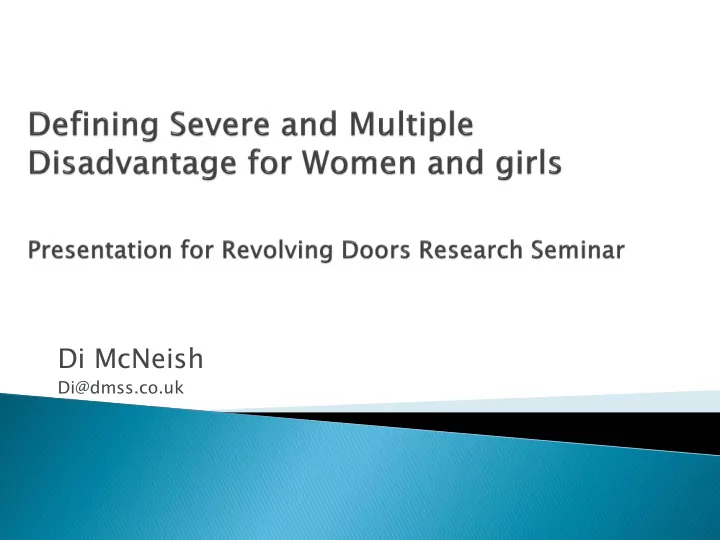

Di McNeish Di@dmss.co.uk
Two projects: 1. Review for AGENDA (completed in May 2014) which considered: What are the risk factors affecting women and girls across the life-course? What do we know about potentially effective support? 2. Current project for Lankelly Chase on developing a profile of SMD for women and girls
There is no such thing as the profile of SMD Different definitions lead to different profiles It is important to surface the concepts which underpin the definitions and portrayals of SMD Taking a gendered perspective is vital 3
Partnership with Heriot Watt Still work in progress Desk review Consultation with other researchers & service providers Consultation with women with lived experience of SMD Review of potential data sources 4
Possible approaches to conceptualising SMD: The defined categories approach The risk factors approach Social inequalities/rights perspective Capabilities perspective 5
Agree the categories of disadvantage to be included and use available data to develop profile of those who appear in them Advantages: provides clear definitions; if the data is available it enables profiling of those experiencing SMD Challenges: profiles are dependent on the categories included; risks being data driven; profiles tend to be fixed in time 6
We asked women: Who are the most SMD women? What’s different about their experience compared to that of SMD men? Homelessness, drugs, prison all came up – but not first The experience and effects of trauma Mental ill health Domestic violence and relationships with men Abused and uncared for in childhood Loss of children Responsibility for children Women without children Migrant women at the bottom Being/not being a ‘proper woman’ Lack of support 7
Do we need different categories and clusters to understand SMD for women? Can we locate data sources for the categories defined by women? To what extent does service use data exclude women? Are there women ‘hidden’ behind SMD men? And if so, how can we identify them? 8
Identify the factors which increase the risk of people becoming SMD & use data (e.g. from population samples) to estimate likely prevalence Advantages: enables wider range of factors to be considered for different groups; enables assessment of risk across life course Challenges: broader – so less focused on SMD; at risk of SMD not the same as being SMD; population samples exclude some SMD groups 9
Famil ilie ies: s: lone e parents ts , those living in social or rented housing, families with three or more children, those with a young ung mother her , a black mother her , and those who live in most deprived areas. Families affected by disability, limiting illness or mental health problem Young g people e 16 – 24: females les, those se living ing independ ndent ently ly with h their ir own childre ldren , those living with a lone parent, social and private renters, and those living in more deprived areas. Working king-age age people without dependent children: wome men, n, older working-age people, those from manual occupational groups, home-mak makers ers, early retirees, sick and disabled people, those who never married, and those living in single-person households. Older r people aged 60 +: those se aged 80 years rs and over, , those who live alone and those who have poor access to services. 10
If women and girls are at equal or greater risk of disadvantage, why do they not feature so much in SMD groups? Is it because disadvantaged men and women have different trajectories? 11
Girls & women at greater risk Abuse in childhood Domestic violence Accumulation – ‘poly - victimisation’ Violence greater risk more violence Poor women at greater risk
Proportion of each violence and abuse group who have attempted suicide APMS Analysis, 2013 29 % 12 10 10 10 2
Pink and blue Maintain inequalities Risk for women’s mental health Double whammy for women who don’t conform
Identify people in those groups most affected by social hierarchies & oppression – those exposed to the most oppressive and toxic consequences of power Advantages: takes account of changing social hierarchies such as migration & global economics Challenges: not an easy fit with data sources 17
Gender is arguably one of the universal stratification systems (men have more of the social and political power in most places) Impacts at both social group and individual level Reinforced by dominant ideologies and institutions Dominant groups get lion’s share of material resources, freedom & choices 18
Freedom from male violence 1. Equal access to education and employment 2. Financial independence, control over life 3. choices and freedom from gendered expectations Sexual/reproductive choice 4. Freedom of movement 5. Shared responsibility for children 6. 19
Which women have experienced the most toxic interpersonal consequences of the gender system e.g. abusive relationships? Which women are additionally disadvantaged through being part of other social groups Which women have had experience of institutions and services which reinforce inequalities Which women have experienced life long material hardship, exploitation and discrimination because of their membership of gender and other disadvantaged social groups?
10 essential capabilities for a good life: ◦ Life ◦ Bodily health ◦ Bodily integrity ◦ Senses, imagination and thought ◦ Emotions ◦ Practical reason ◦ Affiliations ◦ Other species ◦ Play ◦ Control over one’s own environment 21
Which women are least likely to enjoy these 10 capabilities? Are there proxy indicators for their presence or absence? 22
Do they lead to the same groups of women? If so, who are they and where can we find them? 23
Recommend
More recommend